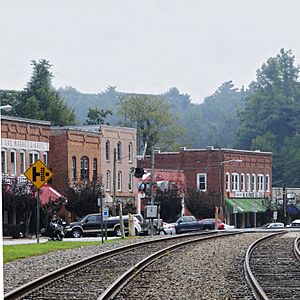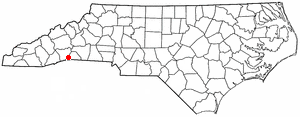Saluda, North Carolina facts for kids
Quick facts for kids
Saluda, North Carolina
|
|
|---|---|
 |
|

Location of Saluda, North Carolina
|
|
| Country | United States |
| State | North Carolina |
| Counties | Polk, Henderson |
| Settled | 1878 |
| Incorporated | 1881 |
| Named for | Tsaludiyi (ᏣᎷᏗᏱ) |
| Area | |
| • Total | 1.55 sq mi (4.03 km2) |
| • Land | 1.55 sq mi (4.03 km2) |
| • Water | 0.00 sq mi (0.00 km2) |
| Elevation | 2,179 ft (664 m) |
| Population
(2020)
|
|
| • Total | 631 |
| • Density | 405.79/sq mi (156.64/km2) |
| Time zone | UTC-5 (Eastern (EST)) |
| • Summer (DST) | UTC-4 (EDT) |
| ZIP code |
28773
|
| Area code(s) | 828 |
| FIPS code | 37-58920 |
| GNIS feature ID | 2405410 |
Saluda is a small city located in Polk and Henderson counties in the state of North Carolina. In 2020, about 631 people lived there. Saluda is well-known for being at the top of the Norfolk Southern Railway's Saluda Grade. This was once the steepest main railway line in the United States. The city is near the South Carolina border, between the larger cities of Asheville, North Carolina and Spartanburg, South Carolina.
Contents
History of Saluda
The name Saluda comes from the Cherokee word Tsaludiyi. This word means "green corn place." The first European settlers called the area "Pace's Ridge." This name came from the Pace family who lived there. Many early families were Scots-Irish. They moved from Pennsylvania around the 1790s. This was during the time of the Whiskey Rebellion.
In 1831, a French consul named Count Joseph Marie Gabriel St. Xavier de Choiseul bought land. He was a cousin to Louis Philippe I of France. He built his home, Saluda Cottages, in the area.
The Famous Saluda Railroad Grade
In 1878, Saluda was very small, with only two houses. That same year, the Southern Railroad was completed. This brought big changes to the area. The Saluda railroad grade is very unique. It drops 600 feet (183 meters) per mile. This makes it the steepest main line east of the Rocky Mountains.
The railroad section had 50 curves, some shaped like a horseshoe. Building it this way saved money. It went over the mountains instead of through them. This part of the railroad was first called the Asheville and Spartanburg Railroad. Workers built the railroad under the supervision of Colonel Andrew Tanner. He also opened the first hotel in Saluda. In 1881, he became Saluda's first mayor.
By 1887, eight passenger trains passed through Saluda daily. About 3,000 visitors came each year. The Saluda Grade was known for train accidents. In 1880 alone, fourteen people died on a 3-mile (4.8 km) stretch of track. Freight trains stopped using the line in 2001. In 2023, a group agreed to buy 31 miles of the Saluda Grade. They plan to turn it into a walking and biking trail.
Geography of Saluda
Saluda is located in the southwestern part of Polk County. A small part of the city also reaches into Henderson County. The elevation on Main Street is 2,097 feet (639 meters) above sea level. At the bottom of the Saluda Grade, in Tryon, the elevation is 1,079 feet (329.1 meters).
U.S. Route 176 is Saluda's Main Street. This highway goes east down the mountain for 8 miles (13 km) to Tryon. It goes northwest 10 miles (16 km) to Hendersonville. Interstate 26 is just north of Saluda. You can get to it from Exit 59. I-26 leads north 34 miles (55 km) to Asheville. It goes southeast 37 miles (60 km) to Spartanburg, South Carolina.
The United States Census Bureau says Saluda has a total area of 1.55 square miles (4.0 square kilometers). All of this area is land.
Earthquakes Near Saluda
Saluda has had more earthquakes than the average for North Carolina. However, the earthquake activity is much smaller than the overall U.S. average.
People of Saluda
| Historical population | |||
|---|---|---|---|
| Census | Pop. | %± | |
| 1900 | 211 | — | |
| 1910 | 235 | 11.4% | |
| 1920 | 549 | 133.6% | |
| 1930 | 558 | 1.6% | |
| 1940 | 539 | −3.4% | |
| 1950 | 547 | 1.5% | |
| 1960 | 570 | 4.2% | |
| 1970 | 546 | −4.2% | |
| 1980 | 607 | 11.2% | |
| 1990 | 488 | −19.6% | |
| 2000 | 575 | 17.8% | |
| 2010 | 713 | 24.0% | |
| 2020 | 631 | −11.5% | |
| U.S. Decennial Census | |||
Saluda Population in 2020
| Race | Number | Percentage |
|---|---|---|
| White (non-Hispanic) | 573 | 90.81% |
| Black or African American (non-Hispanic) | 17 | 2.69% |
| Asian | 2 | 0.32% |
| Other/Mixed | 22 | 3.49% |
| Hispanic or Latino | 17 | 2.69% |
In 2020, there were 641 people living in Saluda. There were 369 households and 231 families.
Saluda Population in 2010
In 2010, Saluda had 713 people. The population density was about 369 people per square mile (142 per km2). Most residents were White (95.65%). About 2.66% were African American.
There were 265 households. About 20.8% of these households had children under 18. Most households (52.5%) were married couples. The average household had 2.17 people. The average family had 2.70 people.
About 14.59% of the population was under 18 years old. About 34.90% of the population was 65 years or older. The median income for a household was $39,063. This means half of the households earned more and half earned less.
Things to Do in Saluda
Saluda's Main Street has many new restaurants and art galleries. Tourists and cyclists often visit on summer and fall weekends. This is because of the many winding mountain roads around Saluda. The city has several main festivals. These include the Saluda Arts Festival, Coon Dog Day, and the Home Town Christmas Celebration. The nearby Green River has challenging whitewater rapids. It hosts the annual Green River Games kayak race in November.
Saluda Festivals and Events
- Saluda Arts Festival: This event showcases fine artists from North and South Carolina. They display and sell paintings, woodworking, photography, pottery, and jewelry. The festival also has live demonstrations. It usually happens on the third Saturday in May.
- Coon Dog Day: This is one of Saluda's oldest festivals. It is a homecoming and celebration. It includes food, live music, a parade, crafts, and a street dance. There is also a 5k race and a benefit breakfast. It takes place on the first Saturday after July 4 each year.
- Home Town Christmas Celebration: During this festival, Main Street is decorated with Christmas lights. Shops are open and offer holiday treats. Local musicians perform. The event ends with a special service at the Saluda Presbyterian Church.
Shopping in Saluda
Most of the shops in Saluda are on Main Street. Other businesses can be found in an area called Nostalgia Court.
Parks and Green Spaces
The Saluda Community Land Trust manages local parks and trails. These include the Lazy Girl Loop and Little Park. There is also a Community Garden. A small park with a playground and picnic area is next to the railroad tracks on Main Street. The Saluda Dog Park is located on Chestnut Street.
Education in Saluda
Saluda Elementary is the public elementary school in the city. It is located on Main Street. The school serves students from pre-kindergarten through 5th grade.
See also
 In Spanish: Saluda (Carolina del Norte) para niños
In Spanish: Saluda (Carolina del Norte) para niños

